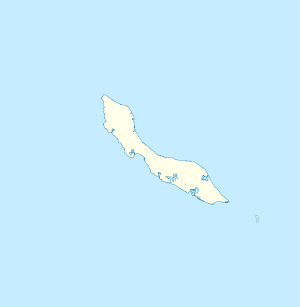Klein Curaçao
Coordinates: 11°59′34″N 68°39′03″W / 11.99278°N 68.65083°W
 | |
 Curaçao | |
| Location |
Klein Curaçao Curaçao |
|---|---|
| Coordinates | 11°59′23.3″N 68°38′35.5″W / 11.989806°N 68.643194°W |
| Year first constructed |
1850 (first) 1879 (rebuilt) |
| Year first lit | 1913 (rebuilt) |
| Construction | masonry tower |
| Tower shape | cylindrical tower with balcony and lantern |
| Markings / pattern | white tower, red lantern |
| Height | 20 metres (66 ft) |
| Focal height | 25 metres (82 ft) |
| Light source | solar power |
| Range | 15 nautical miles (28 km; 17 mi) |
| Characteristic | Fl (2) W 15s. |
| Admiralty number | J6399 |
| NGA number | 16054 |
| ARLHS number | NEA-006[2][3] |
Klein Curaçao (English: Little Curaçao) is a 1.7 square kilometres (170 ha; 0.66 sq mi) uninhabited island south-east of Curaçao in the Caribbean Sea, and is part of the Dutch country of Curaçao. The only structures on the island are an old lighthouse, a beach house, and several huts. Klein Curaçao is well known as a beautiful diving-spot because of its coral and underwater caves. It's fairly easy to spot colorful fish and sea turtles when snorkeling.
Formerly, goats were allowed to roam the island, which contributed to desertification. In 1871, John Godden, an English mining engineer, visited the island, and until 1886 phosphate was mined and exported to Europe. The island was mined out, the level of the island dropped, and seabird populations plummeted. Currently, reforestation is being undertaken by CARMABI Marine Research Station, Curaçao. The island also played a part in the slave trade. The Dutch West India Company brought many slaves from Africa to Curaçao. Before these slaves came ashore in Curaçao, the sick were placed in quarantine at Klein Curaçao. The remains of this first quarantine building can still be found in the northwest of the island. The slaves, and other passengers who did not survive the voyage, were buried at Klein Curaçao. There are several graves in the southern part of the island.
The Dutch West India Company were also given licenses to hunt the highly endangered monk seal on Klein Curaçao. Like its mother island of Curaçao, the island is little affected by hurricanes, but several storms have left their mark. The first was the hurricane of 1877, which destroyed the first lighthouse on the island. The next lighthouse, which still survives, was built in the interior of the island.
Klein Curaçao has no permanent inhabitants, only a few palm-frond covered sheds for day trippers from Curaçao, and apart from some coconut palms has little vegetation. There are some fishermen's huts where fishermen normally stay for some days. They get water from the Coast Guard of Curaçao. The windward side is a graveyard for boats that did not stay out far enough or lost power. A small tanker, the Maria Bianca Guidesman, is gradually being demolished by the constant pounding of the waves. The remains of another four or five boats have been washed far onshore.
Gallery
- Location of Klein Curaçao
 Shipwreck
Shipwreck Beach at Klein Curaçao
Beach at Klein Curaçao
See also
References
- ↑ michaeljohngrist.com
- ↑ Curaçao The Lighthouse Directory. University of North Carolina at Chapel Hill. Retrieved 6 September 2016
- ↑ List of Lights, Buoys and Fog Signals Atlantic Coast. Retrieved 6 September 2016
| Wikimedia Commons has media related to Klein Curaçao. |